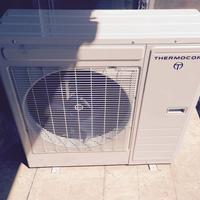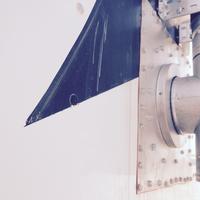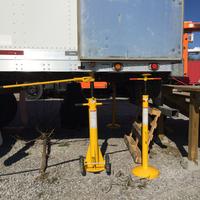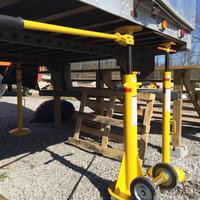Answering Comments & Update
We receive a lot of our comments from truck drivers and this week we received two questions that we’ve been hearing a lot:
“Seems that if you start with an old refrigerated trailer, then it's already insulated -- no need to build walls or add insulation. And that then provides a little more interior space. Why didn’t we go with a refrigerated trailer?”
The amount of insulation in a reefer is actually pretty minimal, and the full time efficiency and level of comfort one expects from a home wouldn't be there. You would liklely have to run heat or cooling full time for most of the year. We decided to go for a lot of insulation to minimize the lifetime energy costs of the home. But that's just our opinion. If you live in California and you don't have huge temperature swings, it might make sense. Then, there's the fact refrigeration units for reefers are not that great, nor are they designed for home comfort. You could do a lot better (and cheaper) with a Toshiba or Fujitsu split ac unit. This is what we are doing. Especially because a reefer unit is generally powered by the cab, and a home is normally powered by 120 AC (or 240V AC for most split systems). Also a new unit would have a warranty, etc... If you do a little research on HVAC systems, you'll find that you're only trying to cool about 5-10 degrees from the ambient temperature to prevent cooling harshness. The units for a reefer are not designed for that. Not to mention, how would you get the airflow all the way down the trailer? We are going to use a split system with one compressor, but THREE independent air handlers. I think the system is only $2,500. You will still need lots of interior framing if you plan on moving the unit. Windows and doors will have to be inset to not exceed the exterior trailer dimensions. We also wanted to minimize the amount of travel and flex of the interior during transit (of which we expect a fair amount of transit).
“Is the trailer still treated under the law as a commercial vehicle? Have to pay Federal highway taxes on it, pull in to weigh stations, have federal inspections, etc?”
The trailer is currently registered and inspected as a commercial trailer and would have to follow all of the same regulations as any other 53' commercially towed trailer (especially if we have a logistics company tow it in the mean time). We may be able to register as something else (like an RV trailer), it's hard to say at the moment. We’re going to operate under the premise that we will leave it registered commercially and will have to comply with all of those regulations and fees, etc.
Also, from a reddit user: “How will we travel? Where will we park it?”
Truck stops, rest stops, Walmart, etc. will be available. Outside of that I think the options will start getting limited. I figure that there will be a number of large national and state parks that can accommodate the Class A rigs and this should fit in a space like that. I have looked for regulations, etc. for national parks on the maximum vehicle size and I cannot find anything. I'm hoping there's no specific rule against it because no one has been crazy enough to try. Ask for forgiveness instead of permission so to speak.
And finally, three questions from a reader in Vermont:
“I am curious to know if and how you decided to deal with snow load, and possibly walking on your roof as this is an issue of concern for us as well given our current location and climate.”
We actually had been toying with the idea of a roof top deck, but have since decided to scrap that idea as we have run out of time for finishing the renovations in general. Basically, the roof of the trailer is slightly convex. It has steel stiffners spaced at about 24" centers all the way down the trailer. But overall, it's basically sprung against the walls, and we wouldn't even walk on it, let alone imagine a moderate snow load (1-2 feet) without permanent damage. We are installing rafters and spacers between the rafters and the roof stiffners to insure the convex shape as well as increase the overal stability of the roof. We're actually doing this part right now, and we haven't had a chance to complete enough to walk on the roof and gauge how well it's working. We imagine that this will provide more than enough support for walking on the roof of the unit without damage. We also imagine it would provide moderate support for maybe a couple feet of snow for small periods of time (which we know is true because this winter, there's been almost 6" of snow on the unit without any damage or re-inforcement of the roof). Would we place this unit in Vermont for an entire winter with feet and feet of snow for months at a time? No, we wouldn't. The winters where we are currently located, although cold, are not particularly snow filled. I would recommend that if one were to park this unit in a place for a snow filled winter, that you would park it under some kind of steel pavilion with a gable roof.
“Also, when you are dealing with venting (as for your pellet stove) and window installation (with outside frames), are you able to keep the total width within the 102" maximum allowable or have you found another way to get around this?”
There are two kinds of items that have been installed on the unit, permanent and removable. All of the doors and windows are permenantly installed, and all of the piping, venting, cabling, etc are removable. The piping and venting are generally interlocking pieces, so that's not a problem. We had to install inserts into the almunium skin that the strapping for the piping can attach to, and can be removed prior to moving the unit. There are pictures of this at the top of the post. As for the doors and windows, we've found that those protrude maybe an inch or two from skin of the trailer. But honestly, the hooks for the swing doors protrude that far also. We really think that the 102" really applies to the structure of the unit (and since we already have a manufactured and registered trailer, we're probably safe there), and no one is going to freak out if a door handle protrudes an inch or two. There are pictures at the top of the post detailing how much the windows protrude. As for the compressor for the split A/C, it's going where a normal reefer unit would go (at the front of the trailer), so we're not worried about that either.
“Do you feel that, in comparison to using a 102' x 53' HC ISO steel container you will still have the structural stability to keep the house safe during windstorms and to put in as may windows and sliding doors as you would like?”
Absolutely. We’re using the 6” steal framing (basically building a box within a box with insulation in-between) to insure we have structural support. The windows and doors will have 3/16 of an inch of steal frame around each opening. Also we purchased six trailer jacks to provide extra stability when parked.
Thanks again for the comments. We've received far more emails than I thought we would and honestly, they just make us feel like we are being encouraged and supported by like-minded people and that is really a special thing.
EDIT AUGUST 2015:
Someone emailed in for info on the jacks. Here's what we bought:
Standing jacks: http://www.globalindustrial.com/p/material-handling/dock-truck/trailer-stabilizing-jacks/economy-trailer-stabilizing-jack-stand









